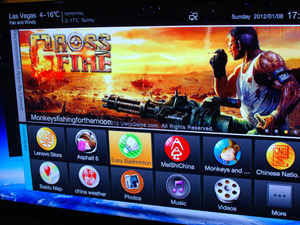CES Unveiled is the first real hands-on time for the press at the yearly gadget-fest. It's the night before the official press day, which is traditionally when smaller, innovative little companies show off upcoming products before the storm of announcements from the big companies.
The Lenovo K91 might just be the smartest smart TV yet. Running a custom-skinned version of Android 4.0, the 55" set will stream video on demand, share multimedia with Lenovo tablets and smartphones (of course), and offer a host of games from a Lenovo-approved Android market, playable via included gamepad or gyroscope-equipped remote. Then it adds voice recognition and an integrated 5MP webcam for good measure. The K91 is will arrive in Chinese living rooms this April, though stateside plans remain undecided.
The Kivic One pitches itself as a small and simple AirPlay device for the car—streaming audio and video from iPhones and iPads to the device (which should launch in March and cost about $200), which can patch into standard A/V inputs in the vehicle. But that marketing pitch actually short sells the device a bit. It's a universal AirPlay interface with a variety of outputs (including HDMI), so while the pocket-sized interface is, indeed, small enough to stash away under a vehicle dash, there's no good reason why it shouldn't work for your home theater as well.
The Griffin Twenty streaming audio device turns any Apple AirPort Express into a stereo system. The machine has a simple and elegant design, just a plug for the AirPort Express and a large, friendly white dial for volume. As its name implies, the Twenty has an internal 20-watt amplifier, left and right outputs for stereo speakers, plus a subwoofer. The concept is that the dial controls the volume, while the rest of the interface is taken care of through your iPhone, iPad or computer. No word on pricing or availability yet.
For 2012, Parrot has updated and expanded upon its Android-based Asteroid receiver, which can turn any car into a connected vehicle and earned Parrot a 2011 Popular Mechanics Breakthrough Award. There are three new devices. The Asteroid CK has a 3.2-inch LCD color screen and 3G or Bluetooth tethering for connectivity, plus voice recognition, hands-free calling and a wireless remote control. The Asteroid NAV will have all of the same connectivity, along with a 5-inch color capacitive multitouch screen (no remote) and onboard navigation. The Asteroid 2DIN will feature an even-larger 6.2-inch color multitouch screen and all of the capabilities of the former two models. All of these devices will be available sometime later this year, but the price is TBA.
Greenwave Reality's booth is begging to be overlooked. There's no single, gee-whiz product, and the topic—smart energy done smartly—isn't as sexy as a barrel-rolling drone. But the ex-Cisco engineers behind this company have created an impressive suite of gadgets that piggyback off of your WiFi network, creating a stand-in for the smart homes to come. The LED and CFL bulbs (which should cost $10 to $20) are controlled wirelessly, each with its own IP address. The company's powerstrips can remotely toggle appliances on and off, as well as automatically detect what kind of device they're powering (discerning a TV from a computer, for example). All of the usage data is pushed to Greenwave's own servers, allowing for access and control over the Internet from users' smartphones, tablets, or computers. It's everything the smart grid promises to do one day, but available right now.
We've seen the future of cooking, and it's... expensive. Luckily, the $5000 Thermador Freedom Induction Cooktop is also an evolutionary leap—instead of discrete heating elements, the cooktop senses induction-compatible cookware placed anywhere on its surface. The touch-sensitive display shows where each pot and pan is situated, maintaining their power level even as they slide around. To reinforce the mad scientist appeal of electromagnetic cooking, it also has a Boost feature, which redirects up to 30 percent of the power from one half of the surface to the other, for even faster heating. Why? Because you can!
The PowerSkin SpareOne may be the lowest-tech cellphone on the market today: it has no screen, a basic number pad, and relies on a single AA battery for power. It's not for daily use, of course; the $50 SpareOne, which can always dial 911 but needs a SIM card to make regular calls, might find a home in your first aid kit, glove box, or storm shelter.
The mission of the One Laptop Per Child (OLPC) project is to design and sell ultra-cheap devices for the developing world. The organization's first product was the convertible laptop XO-1 laptop in 2006. Next up is the approximately $100 XO-3, an 8-inch touchscreen educational tablet with solar and crank chargers. It will be available with an optional Pixel Qi transflective screen, which can alternative between LCD and Kindle-style e-reader modes.









No comments:
Post a Comment